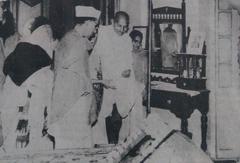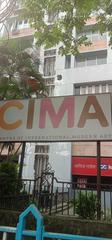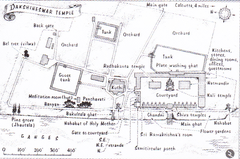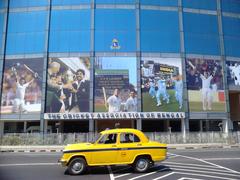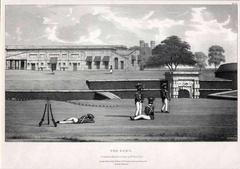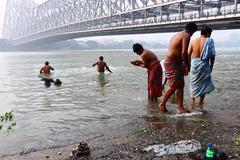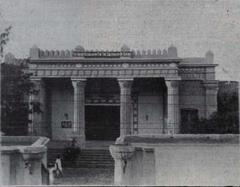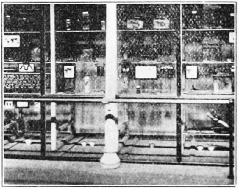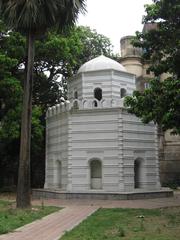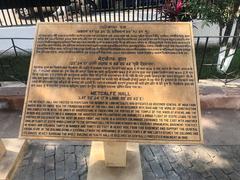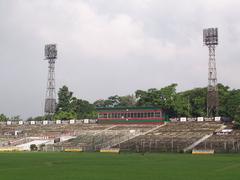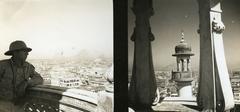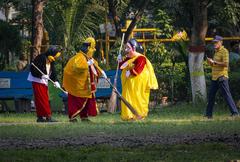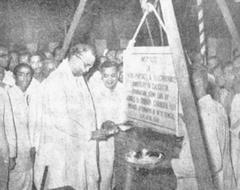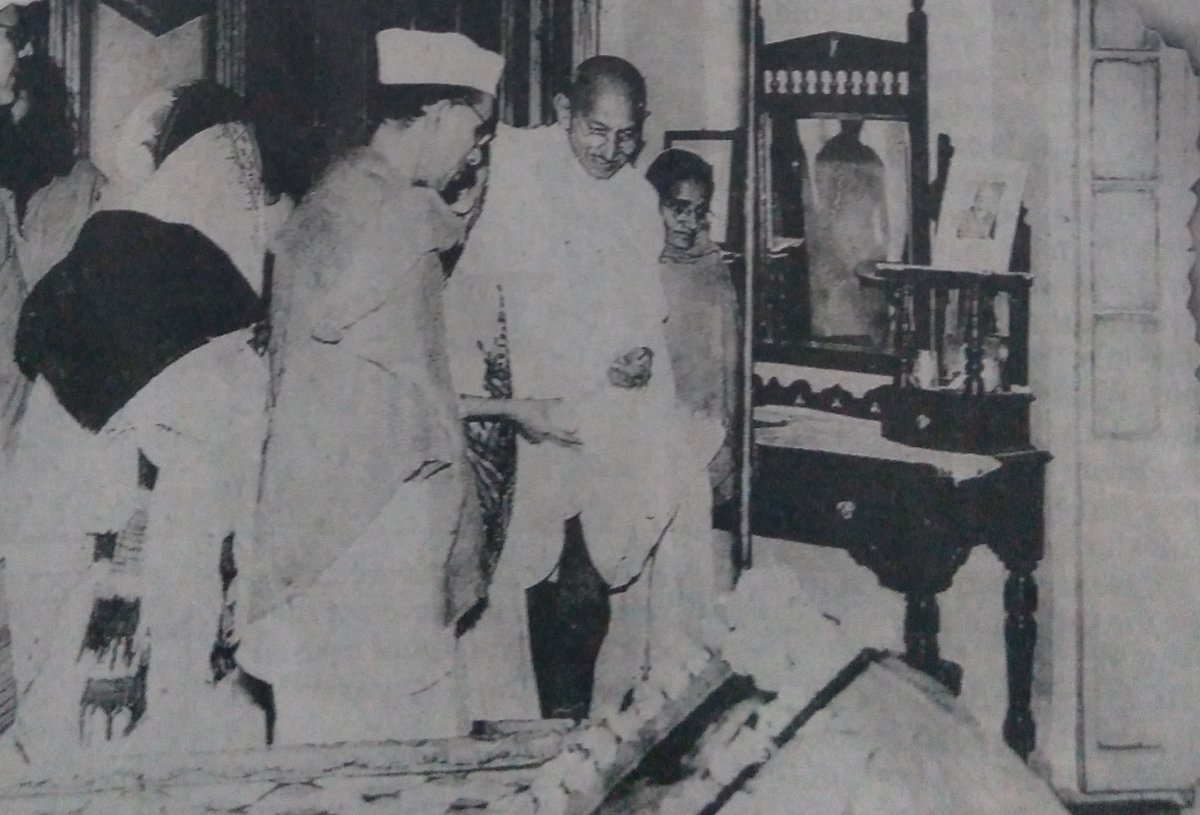
Visiting Hours, Tickets, and History of Netaji Bhawan in Kolkata
Date: 18/08/2024
Introduction
Netaji Bhawan, located at Lala Lajpat Rai Sarani (formerly Elgin Road) in Kolkata, India, is an iconic historical site that offers visitors a profound insight into the life and legacy of Subhas Chandra Bose, one of India’s most revered freedom fighters. This ancestral home, constructed in 1909 under the supervision of Bose’s father, Janakinath Bose, stands as a testament to the rich cultural and political history of early 20th-century Bengal. The building’s architectural elegance, combined with its significant role in India’s struggle for independence, makes it a must-visit for history enthusiasts and casual visitors alike (Indian Culture).
Netaji Bhawan is not only a museum but a vibrant educational center that hosts a variety of events, lectures, and seminars dedicated to preserving and promoting the legacy of Subhas Chandra Bose. The museum houses a vast collection of personal artifacts, documents, and photographs that chronicle Bose’s life and his relentless pursuit of Indian independence. Among its most notable features are the preserved rooms and historical artifacts that offer a tangible connection to Bose’s extraordinary life, including the car he used for his daring escape from British house arrest in 1941 (Kolkata City Tours).
This comprehensive guide to visiting Netaji Bhawan provides detailed information on its architectural heritage, historical significance, visitor experience, and practical details such as visiting hours and ticket prices. Whether you are a local resident or a tourist, this guide will help you make the most of your visit to this important historical landmark.
Table of Contents
- Introduction
- Architectural Heritage
- Ancestral Home and Early Life of Subhas Chandra Bose
- Political Significance
- The Great Escape
- Establishment as a Museum
- The Netaji Research Bureau
- Cultural and Educational Impact
- Preservation of Historical Artifacts
- Global Connections
- Visitor Experience
- Practical Information
- Nearby Attractions
- FAQs
- Conclusion
Architectural Heritage
Netaji Bhawan is a magnificent example of early 20th-century Bengali architecture. Constructed in 1909 under the supervision of Janakinath Bose, the father of Subhas Chandra Bose, the building features grand porticos and traditional pillars characteristic of Bengali households of that era (Indian Culture). The architectural design of the house reflects the aesthetic sensibilities of the time and serves as a physical testament to the cultural and historical milieu in which Subhas Chandra Bose grew up.
Ancestral Home and Early Life of Subhas Chandra Bose
Netaji Bhawan is the ancestral home of Subhas Chandra Bose, one of India’s most revered freedom fighters. Bose spent his formative years in this house, which played a crucial role in shaping his ideologies and political aspirations. The house retains many elements from the early 20th century, offering visitors a glimpse into the lifestyle and environment that influenced Bose (Kolkata City Tours).
Political Significance
During the Indian freedom movement, Netaji Bhawan became a hub of political activity. It was a site where many significant political discussions and strategies were formulated. The house was frequented by prominent leaders of the time, including Mahatma Gandhi, making it a focal point for the Indian struggle for independence (Indian Culture).
The Great Escape
One of the most dramatic episodes in the history of Netaji Bhawan is Subhas Chandra Bose’s daring escape from house arrest in January 1941. Bose was under strict surveillance for his activities against British rule, particularly his calls for Purna Swaraj (complete independence) and his criticism of British war efforts during World War II. Disguised as a life insurance inspector named Mohammad Ziauddin, Bose managed to evade British authorities with the help of his nephew, Sisir Bose. He escaped in a black German Wanderer sedan, which is still housed in the Bhawan as a historical artifact (Indian Culture).
Establishment as a Museum
In 1961, Netaji Bhawan was officially converted into a museum by the Netaji Research Bureau. The museum is dedicated to preserving and showcasing the life and legacy of Subhas Chandra Bose. It houses a vast collection of documents, photographs, and personal belongings of Bose, arranged in a chronological and systematic manner. The museum offers a comprehensive understanding of Bose’s life, from his childhood to his role in the Indian freedom movement (Kolkata City Tours).
The Netaji Research Bureau
The Netaji Research Bureau, headquartered at Netaji Bhawan, has played a significant role in preserving the history and legacy of Subhas Chandra Bose. Established in 1961, the Bureau has collected and curated materials related to Bose from around the world. It also organizes various events, lectures, and seminars to promote research and discussion on Bose’s contributions to India’s freedom struggle (Kolkata City Tours).
Cultural and Educational Impact
Netaji Bhawan is not just a museum but also a cultural and educational center. The Sarat Bose Hall, an auditorium within the Bhawan, hosts lectures, seminars, and symposiums, attracting scholars, historians, and students. The auditorium can accommodate around 115 people and serves as a venue for various cultural activities, especially during the birthday week of Subhas Chandra Bose in January, which sees a significant influx of visitors and a series of celebratory events (Kolkata City Tours).
Preservation of Historical Artifacts
The Bhawan meticulously preserves several historical artifacts, including the staircase used by Bose during his escape and his bedroom, which remains in its original condition. The top floor of the house has been modernized with special effects and lighting to enhance the display of documents, photographs, and articles related to Bose’s life and work. This section of the museum provides a detailed narrative of Bose’s journey from his childhood to his role as a leader of the Indian National Army (Kolkata City Tours).
Global Connections
The museum also highlights Bose’s international endeavors, including his efforts to garner support for India’s independence from various European and Asian countries. Exhibits include photographs and documents related to his meetings with European diplomats and his training of the Azad Hind Fauj (Indian National Army) in Southeast Asia. These exhibits underscore Bose’s global vision and his efforts to build international alliances for India’s freedom struggle (Kolkata City Tours).
Visitor Experience
Netaji Bhawan offers a rich and immersive experience for visitors. The museum’s well-organized exhibits provide a deep insight into the life and times of Subhas Chandra Bose. The house itself, with its preserved rooms and historical artifacts, allows visitors to step back in time and experience the environment in which Bose lived and worked. The Bhawan’s significance as a site of historical and cultural importance makes it a must-visit destination for anyone interested in India’s freedom movement and the legacy of Subhas Chandra Bose (Indian Culture).
Practical Information
- Visiting Hours: Netaji Bhawan is open to the public from 11:00 AM to 4:30 PM, Monday to Saturday. The museum is closed on Sundays and public holidays.
- Tickets: The entry fee for Indian visitors is INR 10, while foreign nationals are charged INR 50. Special discounts are available for students and senior citizens.
- Accessibility: The museum is wheelchair accessible, and guided tours are available upon request.
Nearby Attractions
While visiting Netaji Bhawan, consider exploring other nearby historical sites such as Victoria Memorial, Indian Museum, and St. Paul’s Cathedral. These sites offer a broader understanding of Kolkata’s rich cultural and historical heritage.
FAQs
- Is photography allowed inside Netaji Bhawan? No, photography is not permitted inside the museum to preserve the integrity of the artifacts.
- Are there guided tours available? Yes, guided tours are available and can be arranged at the entrance.
- Can I buy souvenirs at Netaji Bhawan? Yes, there is a small souvenir shop inside the museum where you can purchase memorabilia related to Subhas Chandra Bose.
Conclusion
In conclusion, Netaji Bhawan stands as a monumental tribute to Subhas Chandra Bose’s life and legacy. Its historical, cultural, and educational significance makes it an essential part of Kolkata’s heritage and a vital destination for understanding India’s struggle for independence. Whether you’re a history enthusiast or a casual visitor, Netaji Bhawan offers a rich and enlightening experience that shouldn’t be missed.
For more information and updates, follow us on our social media channels and check out related articles on our website.
Ultimate Guide to Visiting Netaji Bhawan, Kolkata: Hours, Tickets, and Tips
History and Cultural Significance
Netaji Bhawan, the ancestral home of Subhas Chandra Bose, holds immense historical significance. Built by his father, Janakinath Bose, in 1909, the house served as a hub for many significant events in India’s freedom struggle. Today, it stands as a monument to Netaji’s legacy and his relentless pursuit of Indian independence.
Location and Accessibility
Netaji Bhawan is located at 38/2, Lala Lajpat Rai Sarani (formerly Elgin Road), Sreepally, Bhowanipore, Kolkata, West Bengal, 700020, India. The building is easily accessible through various modes of transportation:
- By Air: The nearest airport is the Netaji Subhas Chandra Bose International Airport, which is approximately 20 kilometers away. From the airport, visitors can hire a taxi or use public transportation to reach the museum.
- By Train: The closest major railway stations are Howrah Railway Station and Sealdah Railway Station. Both stations are well-connected to the rest of India. From these stations, visitors can take a taxi or public transport to reach Netaji Bhawan.
- By Metro: The nearest metro station is Netaji Bhawan Metro Station, which is a short walk from the museum.
- By Road: The museum is well-connected by road. Visitors can get down at the Sarat Bose Elgin Road Crossing Bus Stop and proceed to Netaji Bhawan. Taxis and cabs are also readily available for easy commutation.
Timings and Entry Fees
Netaji Bhawan is open to visitors from 11:00 AM to 5:00 PM. The ticket counter closes at 4:15 PM. The entry fees are nominal:
- Adults: ₹5
- Children: ₹2
These timings and fees make it accessible for a wide range of visitors, ensuring that everyone can learn about the life and contributions of Subhas Chandra Bose.
Museum Layout and Exhibits
The museum is housed in the ancestral residence of Subhas Chandra Bose, built by his father, Janakinath Bose, in 1909. The building retains its traditional Bengali architectural style with pillars, porticoes, and courtyards. Upon entering, visitors are greeted by a plaque bearing the name of J.N. Bose.
- Ground Floor: The ground floor features a replica of the INA Memorial engraved with the motto ‘Ittefaq. Itmad. Kurbaani’ (kolkatatourism.travel). This floor also houses several personal artifacts and furniture belonging to Sarat Chandra Bose and Jankinath Bose.
- First Floor: The first floor includes Netaji’s bedroom, preserved in its original condition. The staircase and the car used by Netaji to escape from house arrest in 1941 are also on display, providing a tangible connection to his daring exploits (yometro.com).
Special Features and Highlights
- Footprints of Netaji: One of the most poignant exhibits is the relics of Netaji’s footprints, preserved and displayed in the museum. These footprints serve as a powerful reminder of his journey and struggles.
- Escape Car: The car that Netaji used to escape from house arrest in 1941 is one of the most significant exhibits. This car symbolizes his relentless pursuit of freedom and his strategic brilliance.
- INA Memorial Replica: The replica of the Indian National Army (INA) Memorial is another highlight. It stands as a testament to Netaji’s efforts in organizing the INA and his collaboration with the Imperial Japanese Army to fight against British colonial rule (kolkatatourism.travel).
Visitor Tips
- Best Time to Visit: The best months to visit Netaji Bhawan are May, June, July, and August. During these months, the weather is relatively pleasant, making it easier to explore the museum and its surroundings.
- Photography: Photography is generally allowed, but it is advisable to check with the museum authorities for any specific restrictions.
- Guided Tours: For a more enriching experience, visitors can opt for guided tours. These tours provide in-depth insights into the life and contributions of Subhas Chandra Bose, making the visit more informative and engaging.
- Nearby Attractions: Visitors can also explore nearby attractions such as the Victoria Memorial, Indian Museum, and St. Paul’s Cathedral, which are all within a short distance from Netaji Bhawan (yometro.com).
Contact Information
For any queries or additional information, visitors can contact the museum at:
- Phone: 033 2486 8139
- Address: 38/2, Lala Lajpat Rai (Elgin) Sarani, Sreepally, Bhowanipore, Kolkata, West Bengal, 700020, India
Additional Resources
For more detailed information, visitors can refer to the following sources:
Conclusion
Netaji Bhawan is not just a museum but a living testament to the indomitable spirit of one of India’s greatest freedom fighters. Its rich collection of artifacts, well-preserved historical rooms, and engaging multimedia exhibits make it a must-visit for anyone interested in Indian history and the life of Subhas Chandra Bose.
References
- Indian Culture, 2023, Ministry of Culture, Government of India source url
- Kolkata City Tours, 2023, Kolkata City Tours source url
- Lonely Planet, 2023, Lonely Planet source url
- Yometro, 2023, Yometro source url
